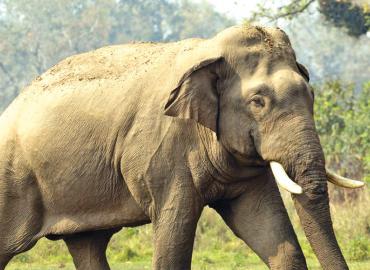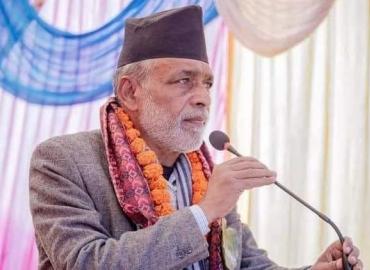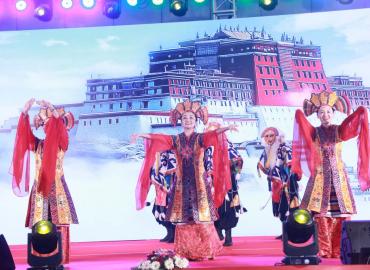Jhumra dance is a historic, cultural and religious dance of Nepal’s indigenous Tharu communities spreading from East to West. At some place, this dance is called ‘Jhumra’ or ‘Dhumra’ and at some place, it is called ‘Bidhyapait’.
How it is danced?
This dance is performed at group in union, and so might be the reason it is called Jhumra. In performing this dance, Nayak (actor) and Natuwa (dancing actress) behave like love birds and they might flirt each other also. While dancing if the Nayak happens to touch Natuwa, Natuwa calls Nayak a Dhumra and Nayak replies calling Dhumri.
Jhumra dance is danced in group. It requires at least 6 artists. It is better if it is more than 6. To increase the artists’ number, Natuwa and Pachuwa are added. This dance includes actors named Nayak, Sahayak, Mridangawadak, Nartak, Pachhuwa and Bipatar, etc. Major musical instruments to be used in this dance are Jhyaali and bigger Madal. Nayak is the main dancing character. First he sings playing Jhyali and Sayak and Pachhuwa follow him. Ganapait plays Mridanga. Bipatar acts like comedian. Natuwa sings while dancing. This dance is performed based on religious rituals like Krishnalila, Ramcharitra, Mahabharat, Premsagar, Anusagar, etc.
Jhumra: also a religious ritual of Tharu
Tharu worship god named Chordev and Jhumra dance is indispensible ritual of Tharu in occasions like sanitization ceremony of newborn and the very first day of newborn’s haircut by barber.
Those Tharu who don’t worship Chordev as their clan god and non-Tharu, who are infertile, have children with prolonged diseases and lost their kinds, also promise to worship Chordeuta in order to end their perils. If their perils are ended, they establish Chordev and Jhumra dance is performed. The Jhumra dance performed after establishing Chordev is called Chorkheliya.
Chorkheliya dance is performed up to 15th of a month in every alternative day like 1, 3, 5,7,9,11,13, and 15. People’s promise to worship Chordev is also done in alternative day. Those whose wishes are fulfilled by Chordev, they establish Chordev as early as possible. Wealthy people establish Chordev in the same year and those who are poor do in another year.
A person, who promises to worship Chgordev, invites all neighbors and relatives. If Chordev was to establish instantly, the invitation is followed by Jhumra dance in the same day and at the same time. Based on this trend Tharu has a saying called ‘Aga aga dal, pachhase chal’.
Chorkheliya dance starts after the full moon day. Those promising to worship Chordev have to sanitize their home and also they have to arrange a doer called Karta.
Karta has to abandon salt, oil and meat items until the dance concludes. If he is undergoing physical ailments, he can consume salt after three days. Karta must have separate kitchen. It is believed that if the kitchen of Karta is touched by others, they will be troubled by one who plays Chordev. In the day of home sanitization, devotees and one who promises to worship Chordev are given bedding in the courtyard at the evening along with oil lamps. Oil lamp is lighted by Dhami (Shaman) or by a dancing member. After the oil lamp is lighted, Dhami reads Vedic mantras and blows the oil. The same oil is used by all members of the dancing group in a belief that this chases away all ill fortunes during the dance.
After putting oil, they sing Jhumra. After signing 5 songs related to Jhumra, the prayer team stands up. Them, the dancing member ask a long cloth and erect a curtain there. Natuwa enters the stage after the prayer starts. On one side of curtain are dancers, singers and music players and on the other side are comedians to make people laugh. Gradually, Natuwa bows down for permission to dance from gods of east, west, north and south. As and when the permission is asked, the curtain is lifted and Natuwa bows down to the feet of Mridangawadak, Nayak, Jhyaali, Sahayak and all other actors and starts dancing.
While dancing, Natuwa and Bhaktiya take a break after singing typical songs of Dhamour, Saijni-Raijni, Prabhesh, Dharuwa etc. If audience are unmoved even after the break, the dance keeps going. Else, the prayer team and Natuwa go for sleep. The very next day, artists of the dacing group make ornaments of jut to decorate one who plays Chordev.
The newly made ornaments are placed in a box and put at the sanitized space of one who promises to worship Chordev. The ornament box is carried by one who plays Chordev and taken to the holy place made by planting a weed called Siki.
Natuwa makes the sun and moon with powered rice. The sun and moon made this way are worshipped with mastered oil, rice, Sindoor, betel leaf and betel nut. Natuwa, other members of artists and the family member pray sun god with milk. Afterwards, the helper of Chordev decorates Chordev with jut ornaments. One of relatives who plays Chordev will walk with Chordev as his assistance.
Ornaments are placed at holy Ghat and Chordev is prepared. Some bring ornaments from holy Ghat and place this at their own clan god. Though it is given named called called Chor (thief), Chordev is regarded as a symbol of the god named Damodar and is sent to bring alms.
Chordev gets first alms at his own home and then to neighbors. Each owner of home washes foots of Chordev and his assistance and asks them to seat on jut mat. Else, Chordev and his aide keep standing.
Natuwa come and start dancing. While dancing, the home owner worships his clan god and cut the ornaments of Chordev. Chordev is place at an auspicious place of the home. The long hair of Chordev is unfurled and his face is covered with attached cloth on his hair and the water is poured from jug on the ornaments to be cut by home owner. While pouring water, the home owner takes the sword of Chordev and cuts his ornaments. The cut out ornament is further sliced in two equal parts. The ornaments taken by cutter are placed on the hair lock of Chordev. Ornaments taken by assistance are given to the one who cuts ornaments. This work is called Banh Katne.
Ornaments cut out from Chordev and a piece of fishing net is draped on newborn until 12 days to prevent evil eyes. After cutting the ornaments, Chordev is taken to the door of worshipping room by one who cuts ornaments. The home owner stands by the door and begs. He is given rice, weed and betel nut and this process is called Gharbharoun. Chordev is given cash while his ornaments are being cut. Natuwa and Joker cautiously dance while giving cash. Likewise, half the amount given to the Chordev is collected by Joker and Natuwa from house owner using every possible trick they have. Small kids are carried for a while by Chordev for their long and healthy life. All homes where Chordev enters undergo this same ritual.
Whose health is wished to recover with promise to worship Chordev, he is made Chordev himself. In cash of small boy or a matured lady, Chordev can be made by some other fellow for cash.
Generally, after visiting 5 homes for alms, Chordev returns to the home, where promise to worship Chordev is made, and undoes his ornaments. If a promise to worship Chordev is made for wellbeing of a kid, he is carried and roamed up to 5 homes and returned. The Chordev made by grownup daughter is also returned after visiting 5 homes. In this special occasion, the hired Chordev is fed and taken with dancing team. If there is time to go next village, they go in the same day. Else, they sleep that day in the same house and travel tomorrow.
While travelling, if an ornament is lost from Chordev, it is believed that the ornament is found along with the ornament placed at the box of home. There is no certain place to shelter after exiting the home where the dance has started. It is tradition to bring dance to every home which invites this dance. Those willing to give shelter send message. Some ask while being danced itself. Poor families make provision of food and shelter in collective way.
If no home invites to stay overnight for dancing team, the team goes back to the home where it was promised to worship Chordev for a wish. However, there is remote possibility to be unable to get shelter after leaving the home promising to worship Chordev for a wish. It is because Tharus are seen waiting to welcome the dancing team once they are informed on Chorkheliya dance.
Those sheltering wash foots of Chordev and assistance. After Natuwas starts dancing at courtyard, Chordev is placed at an auspicious place of the courtyard. Then, ornaments of Chordev is undone is place at the place of their clan god. After undoing ornaments, the Chordev turns into an ordinary person again. The house sheltering the dancing team offers dinner and the dance keep continuing.
The dancing ritual of all homes, including one who has polished to worship Chordev for a wish is same. If time favors, dance called Mannach or Tharnach is performed. In Mannach, the romantic intimacy of Radh and Krishna is shown and in Tharnach, Natuwa dances based of demanded songs. Demanded songs include Bajar Tehri, Tokni Bakhan, Hemti Bakhan, Mejura Bakhan, Chanda Maalin, Budhiya Maalin, Kusmi Maalin, Madhuwalaal, Hemtike Malaar, Aingnahuroun, Paratai, etc.
If the audience is available and dancers are not tired, this continues all over the night. If audience is decreased or dancers are tired, dance is paused after a notice. All take dinner and sleep thereafter.
After having morning snacks, home owner gives back the ornaments. After Naiknait puts ornaments on Chordev, the home owner takes a part of ornament from Chordev. But, in some homes, ornaments are not cut out. Whether they cut or not, the home owner wave goodbye to dancing team.
While travelling, if the Chordev happen to defecate, his ornaments are hold by Natuwa. Chordev only puts ornaments after being sprinkled with holy waters. And, the team moves onwards.
After all ornaments are cut, Chordev and dancers are to stay at those promising to worship Chordev for a wish. Therefore, wealthy relatives of Chordev try to cut ornaments. Their intention for this is to lower hardship of travelling a lot visiting many homes. However, if they are to stay at a home, their cash and alms are less and Natuwa and Joker don’t allow cutting all the ornaments. They ask special alms for those relative willing to cut all ornaments. If their demanded are addressed, they allow. Else, they are reluctant. But, relative make Natuwa and Joker happy and they cut ornaments. This process is called Jhalla-Kharoun.
It is tradition to give land, gold ornaments and domestic animals like cows and buffaloes by those who cut ornaments to Chordev. Likewise, till the last day of their promise to worship Chordev for a wish, Chordev, Natuwa and the dance team is to be fed and sheltered at home.
To conclude this promised dance, all are taken to holy Kurkhet. If all ornaments of Chordev are not cut, they are cut by members of the family in front of the clan god after a ritualistic worshipping. All ornaments are wrapped inside a piece of cloth, from the hair lock of Chordev, is tied with rope and placed in box and the one who plays Chordev is carried and taken to holy Ghat. If Chordev can’t carry the ornament box, the Natuwa is urged for this after giving Dakshina.
In holy Ghat, the elephant made by ash gourd and the horse made by sponge gourd are tied to a rope hold by Chordev who is seated with his head on ornaments. The hanging elephants and horse is sacrificed using sword by Natuwa. In this process, the packed ornaments are taken to the water and borrowed inside the water. It is concluded the way it began in an auspicious place having weed called Siki Jhar.
Pigeons and he-goats are scarified nearby where ash gourd and sponge guards were scarified and artists return singing a song called Jaachair.
After concluding Chorkheliya dance in disciplined manner, the Karta can dine like others. In that day, neighbors and relatives are invited by the home to feed.
Final stage of month-long Jumra Dance
A farewell dance is performed to beg sorry for wrongs done during Chorkheliya dance. If time is favorable it happens on the same day. Else, artists gather after 4 days to dance which is called Samhar. Natuwa is given farewell on the same day or on any other upcoming day. The farewell is like seeing off the after her marriage.
Challenge to lure young generation in Jhumra dance
Previously, artists of Chorkheliya would dance for free. Only Natuwa would be given cash. They would sit on rice or on jute during special ritual of Chordev and cutting ornaments. Rice and jut offered as offering world be collected and the same rice and jute would be distributed among prayer team as their salary. However, in these days, the prayer team is invited with stated cash.
Ways to protect and preserve Jhuma
Therefore, community elders say those who haven’t pierced their nose are not supposed to dance and those who have pierced their nose can’t worship their clan god. Some, wealthy Tharu would establish a dance club and would accept any Natuwa from any community to dance piercing their nose. In return, they would give land, gold ornaments, cash, etc. And, the same Natuwa dance Jhumra these days.
There are not many living artists to continue this historical, religious and cultural dance. Very few elders, inspired by their seniors, are in existence. Tragically, do don’t have written scriptures on Jhumra dance and it is hard to teach young generations about this dance.
In that time when there were very few options of entertainments, such dances would entertain folks. However, the new generation doesn’t care about this typical Tharu dance. The major challenge in this time for this dance is the duration taken by this dance. Youths are not ready to dance continuously for 15 days. There, such historical, religious and cultural dances are being extinct day by day.
It is urgently required to protect, preserve and promote this dance by Tharu leaders, elders, intellectuals and artists. If we happen to be late, the existing dance will also be extinct for sure.
Therefore, we must reform this dance in systematic and time-bound manners. If we are to accommodate new generation and move forward, this organic, historic, religious and cultural dance of Indigenous Tharu community will be preserved.


























